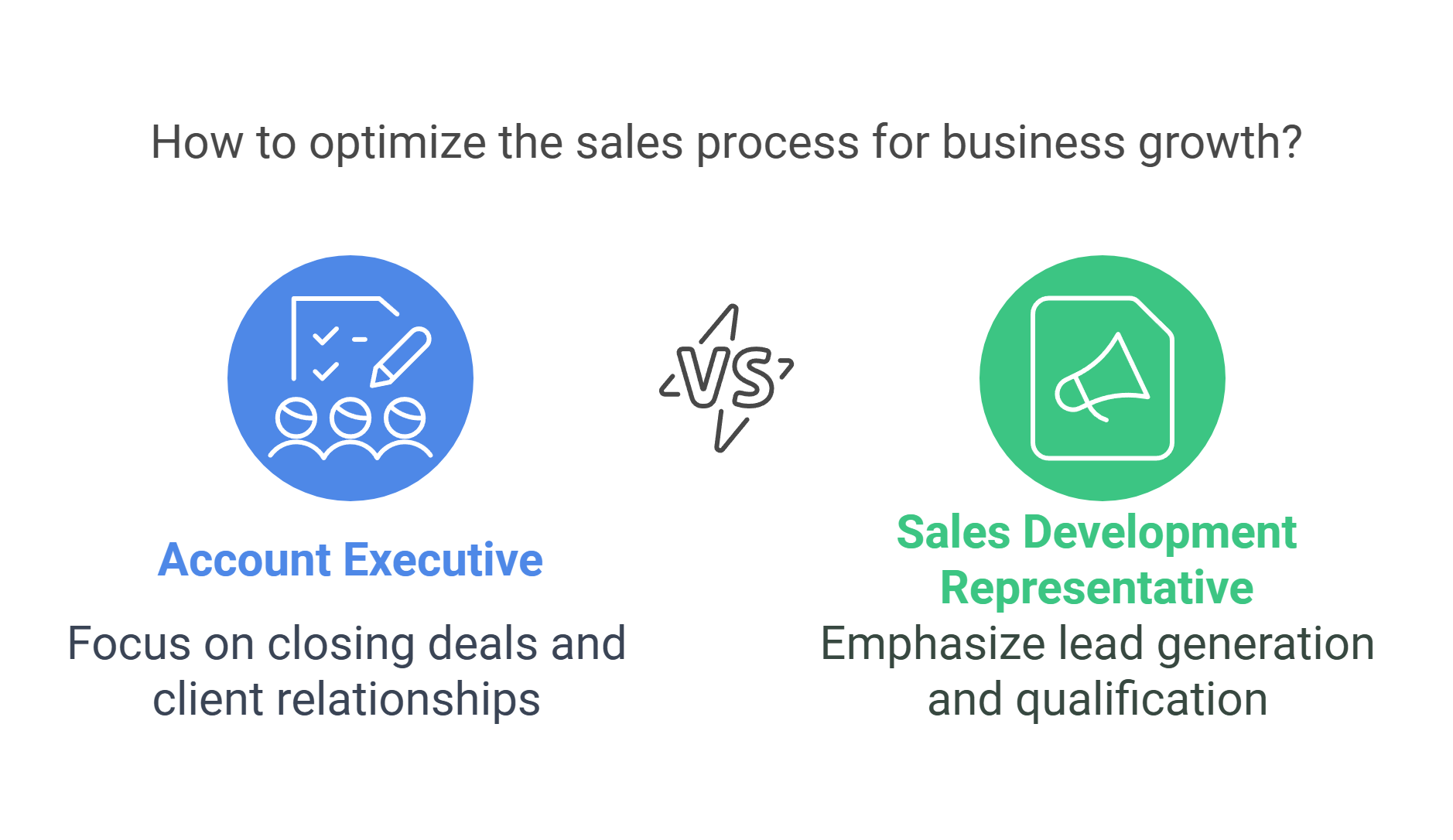Account Executives and Sales Development Representatives are the dream team when it comes to growing your business. They each play unique roles, but they’re both essential for building a solid sales process. Let’s break it down: what exactly does each role do, and why are they important? Here’s the lowdown.
What Does an Account Executive Do?
The job of an Account Executive (AE) is all about building and maintaining relationships. AEs not only focus on keeping your clients happy but also step in when potential customers are ready to make a purchase. In smaller companies, AEs may wear multiple hats, combining their role with the sales executive (or sales representative) role. But as your business scales, having a dedicated AE team focused on closing deals becomes a game changer.
Here’s where AEs shine:
- Closing the Deal:
Once a lead checks all the boxes and is ready to make serious moves, that’s when an AE enters the picture. They handle everything from follow-ups to proposals and answer any last-minute burning questions. When it comes down to negotiation—pricing, terms, conditions—you’ve got an AE to lock it all in. - Understanding the Client and Solving Problems:
Great AEs listen and empathize. They take the time to understand their client’s needs, pain points, and challenges. With that knowledge, they show how your product or service is the perfect fit. Their goal? To make your business the only choice worth considering. - Upselling and Cross-Selling Opportunities:
AEs spend a lot of one-on-one time with clients, which gives them insight into potential ways to upsell or cross-sell other products or services. By focusing on finding unique solutions for the client, they’re able to close deals and drive revenue effectively.
Without AEs, your business would struggle to close deals—and the hard work of getting leads in the first place could go to waste.

What Does a Sales Development Representative Do?
Sales Development Representatives (SDRs) are the gatekeepers of the sales pipeline. They’re the ones keeping your pipeline full of potential clients, finding leads, and making sure the right people get connected at the right time. If AEs are the closers, SDRs are the openers.
Here’s what SDRs focus on:
- Finding Potential Clients:
SDRs are the ones reaching out to prospects—whether it’s through cold calls, emails, responding to inquiries, or connecting on social media. They introduce people to your business, pitch why you’re a good fit, and figure out whether they’re a solid lead. - Qualifying Leads:
It’s not enough to just have leads; they need to be good leads. Once an SDR figures out a prospect has potential, they nurture that lead until it’s time for them to meet with an AE. If the prospect doesn’t seem likely to close, they’re shifted out of the pipeline so time and resources aren’t wasted. - Setting Appointments:
Once an SDR identifies someone as ready to move forward, they schedule a meeting for the AE to jump in. These leads are already warmed up, meaning the AE has a better chance of converting them into long-term clients.
Why You Need Both to Succeed
When you’ve got a strong SDR team keeping your sales pipeline full, your AEs can focus entirely on closing deals. Together, they’re an unstoppable pair, boosting conversion rates and driving revenue.
Think of it this way: SDRs find the opportunities, plant the seeds, and nurture the leads until they’re ready. AEs then come in, build trust, and seal the deal. It’s a one-two punch that can take your business growth to the next level.

Why Outsourcing SDRs Might Be the Way to Go
Not every business has the time or resources to build and manage an SDR team from scratch. That’s where outsourcing SDRs can really make an impact. Here are a few reasons why using “SDR as a Service” might be worth considering:
- Save Money:
Hiring and training a whole SDR team can get expensive. With SDR as a Service, you only pay for what you need, cutting down on costs like onboarding and management. Plus, you get access to expert sales reps instantly. - Save Time:
Building a sales strategy that works takes time. Outsourcing means you can hit the ground running, with experienced SDRs capable of generating leads right from the start. - Access to Top Talent and Tools:
The companies that specialize in outsourced SDRs already have the best practices, tools, and people in place. That means better results, faster.
Key Takeaways
If you want a sales process that works, having both SDRs and AEs on the team is essential. While SDRs focus on outbound prospecting and moving leads through the pipeline, AEs are all about nurturing customer relationships and closing deals. Put them together, and you’ll have a predictable pipeline, higher conversion rates, and, ultimately, more revenue.
Need help building out your SDR team? Or thinking about outsourcing? It’s never too early to invest in a sustainable sales process that keeps your business growing.
Ready to ramp up your sales game? Partner with SDR experts who know how to keep the leads flowing and help your AEs close more deals! Reach out now, and let’s make it happen.







